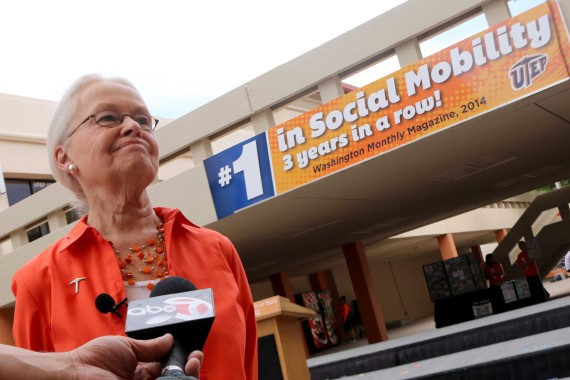The 2014 ranking released by Washington Monthly Magazine place UTEP at No. 8 out of 277 universities, a drop down from the 2013 ranking.
“UTEP, again, is ranked among the top ten universities in the entire United States by Washington Monthly magazine. How cool is that?” UTEP President Diana Natalicio said at an Aug. 26 announcement ceremony.
For the past three years, UTEP has consistently ranked No. 1 in social mobility, or the recruiting and graduating of low-income students. In research expenditures spent in the millions, UTEP was ranked No. 139, a jump up from the 2013 ranking. In community service participation, UTEP was ranked No. 136.
In the category of social mobility there was a decrease in the amount of students receiving Pell Grants from 67 percent in 2013 to 59 percent in 2014.
There was also an increase in net price—the difference between the full cost of attending UTEP minus grants and scholarships a student might be eligible for—from $2,543 in 2013 to $3,258 in 2014.
Gary Edens, vice president of Student Affairs, said the decrease in Pell Grants was due to less money given to the university by the federal government.
“I mean, that’s how simple it is,” Edens said. “The amount of money we have every year is based on the federal government and unfortunately that number has been decreasing.”
Craig Westman, associate vice president for enrollment management solutions, said the decrease was due to the federal government enforcing what is known as the 600 percent rule.
The federal Pell grant aid a student receives is limited to six years, because the maximum amount a student can receive from Pell Grants is 100 percent, the six year equivalent is 600 percent.
According to Westman, before the federal government started enforcing the 600 percent rule, students could transfer to another school and go over the six-year limit.
“Everyone’s Pell numbers went down and it’s because they (the federal government) enforced the 600 percent rule…it impacted a lot of our students, and of course, everyone nationally,” Westman said.
University of California at Berkley, Stanford and Case Western Reserve University, three of the top ten nationally ranked universities in 2014 by Washington Monthly were the only ones that saw an increase in the percentage of students receiving Pell Grants from 2013 to 2014.
According to Westman, at UTEP approximately 76 percent of students receive Pell Grants.
Despite the drop in ranking, Edens said UTEP will continue to strive
for excellence.
“We don’t do what we’re doing because of some ranking,” he said. “If you stay true to yourself then you can do great things.”
Washington Monthly created their college rankings in 2005 as a counter against traditionally esteemed ones like the one from U.S. News and World Report, which Paul Gastris, editor in chief of the Washington Monthly, said rely “on crude and easily manipulated measures of wealth, exclusivity and prestige for its rankings.”
Maria Esquinca may be reached at [email protected].










